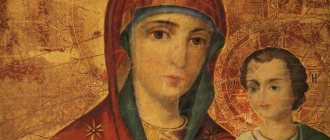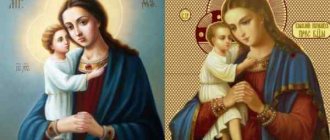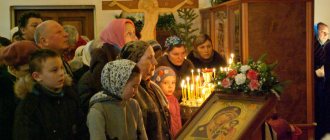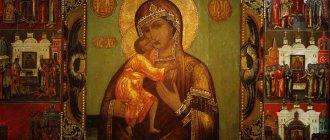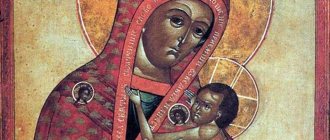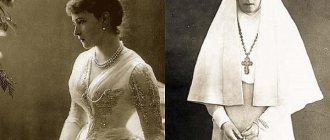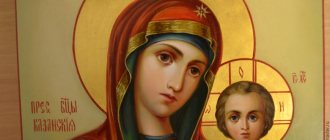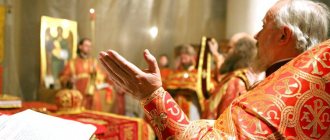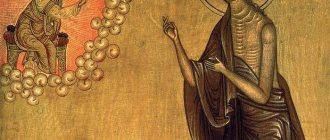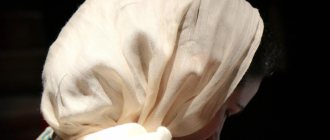"Save me, God!".
Thank you for visiting our website, before you start studying the information, please subscribe to our Orthodox community on Instagram, Lord, Save and Preserve † - https://www.instagram.com/spasi.gospodi/. The community has more than 60,000 subscribers. There are many of us like-minded people and we are growing quickly, we post prayers, sayings of saints, prayer requests, and timely post useful information about holidays and Orthodox events... Subscribe. Guardian Angel to you!
The Smolensk Icon of the Mother of God is one of the oldest icons. The legend says that this image was painted by the Evangelist Luke during the earthly life of the Most Holy Theotokos. In the middle of the 11th century, this divine image came to the lands of Rus'. It is believed that this could have been a wedding gift for the wedding of the daughter of the Byzantine Emperor Constantine IX with the Chernigov prince Vsevolod Yaroslavich.
Before his death, he bequeathed this image to his son, Vladimir Monomakh. It was thanks to him that this face was moved to the cathedral church of the Assumption of the Blessed Virgin Mary in Smolensk in 911. This place soon became her main abode. Since then, the image received its name - the Smolensk Icon of the Mother of God “Hodegetria”.
The meaning of the Smolensk Icon of the Mother of God
This divine image visited many countries: for several decades she stayed in Moscow in the Novodevichy Convent. Then, while the Poles were in Smolensk, she stayed in Yaroslavl. And only in 1655 she was able to return back to Smolensk.
The best article for you, go to: Saint Methodius of Moravia
This divine image has been revered since the beginning of the 12th century. Translated from Greek, it means “Guide”. This name was not given to her by chance. A large number of very important events in the country ended successfully thanks to the sincere prayers of Orthodox Christians before this face.
She leads the country all the time, protecting it from terrible epidemics, protecting it from bloody wars and lands from conquest.
Orthodox Christians believe that the image of the Smolensk Mother of God will bring harmony and peace to the home in which it is carefully preserved and honored. The Smolensk icon helps to calm down the hostility of warring parties, as well as resolve family conflicts.
There are several options for the appearance of the name of this divine image. But all Orthodox Christians know that it is a guide to the salvation of humanity. He always helps those who pray to her with a pure heart and heals them from serious illnesses, helps them find peace in family matters, resolve difficult situations, and is our first intercessor before the Lord God.
If in any situation you do not know what to do, then pray to this divine image and it will help you make the right decision.
The idea of the image of Hodegetria
The defining theological idea of this image is the coming of the Son of God into the world, the incarnation of God for the sake of the salvation of mankind. The Fragile Baby is the Heavenly King and the Coming Judge. The gesture of the Mother of God’s right hand can be interpreted not only as a prayer gesture, expressing Her personal prayer to God. With this gesture, the Mother of God seems to point believers to the One to whom their thoughts and prayers should be directed.
N.P. Kondakov, who studied the iconography of the Mother of God, believed that the image of Hodegetria is one of the most ancient. It developed in Palestine or Egypt before the 6th century. Starting from the 6th century, it spread widely throughout the Orthodox East and Byzantium.
Mosaic icon. Byzantium. XIII century Monastery of St. Catherine, Sinai, Egypt
According to Church Tradition, the first such icon of the Virgin and Child was painted by the Apostle and Evangelist Luke. In the middle of the 5th century, this image, along with other shrines, was brought from the Holy Land to Constantinople by Empress Eudokia, wife of Emperor Theodosius the Younger. Some sources report that the icon was placed in the church of the Odigon convent, but during Holy Week the icon was transferred from the monastery to the imperial palace. Near the monastery there was a spring that healed the blind. The nuns took care of those who came to the source. The area was called “the place of guides”, or “the place of leaders”, and the monastery began to be called Odigon - “Guide”, “Guide”. Based on the name of the monastery, the main shrine - the icon of the Mother of God - began to be called Hodegetria. Initially given as a topographical name, it was also endowed with a deep meaning: the Mother of God is a guide to believers, instructing them in the true, even if protecting them from the enemy. The icon was one of the most revered shrines of Constantinople and was considered the palladium of the city. During enemy attacks, the image was raised to the city walls.
Empress Evdokia. Marble icon with inlay. From the church of Lipsa Monastery. X century Archaeological Museum, Istanbul
Researchers believe that it was with the icon of the Odigon monastery that a procession of the cross took place throughout Constantinople on Tuesdays. During this prayer procession, a miracle regularly occurred, which was described by the Russian pilgrim Stefan Novgorod, who visited the capital of Byzantium in 1348 or 1349. The heavy, large icon was carried across the square by only one person. “That icon is taken out every Tuesday. This is an amazing sight: then all the people come together, and they come from other cities. This icon is very large, skillfully bound, and the singers walking in front of it sing beautifully, and all the people cry with tears: “Lord, have mercy!” ... It’s a wondrous sight: seven or eight people place the icon on the shoulders of one person, and he, by the will of God, walks as if unburdened by anything,” reports Stefan. Numerous miracles and healings took place in front of the icon.
Our Lady Hodegetria. Byzantium. 1st quarter of the 15th century
According to one version of the legend, the icon written by the Apostle Luke and brought from the Holy Land ended up in the Blachernae Church, where there was also a healing spring and where other shrines were kept: a robe and part of the belt of the Virgin Mary. Perhaps one of the copies made from the original icon by the apostle was placed in the Blachernae church. It is known that several copies were made from the original image, which became famous for miracles. In any case, in the Blachernae Church there was a particularly revered icon of the Mother of God Hodegetria.
Blachernae icon. Wax mastic. XIII - XIV centuries Assumption Cathedral of the Moscow Kremlin
Numerous copies of the miraculous image of the Mother of God Hodegetria were sent to all parts of the empire and beyond. From Byzantium, the iconographic type of Hodegetria came to Rus', where, based on the place of creation, stay or miraculous discovery, similar icons received names: Toropetskaya, Smolenskaya, Tikhvinskaya, Iverskaya, Sedmiezernaya, Kazanskaya.
Our Lady Hodegetria. Pskov. The end of the XIII - the beginning of the XIV century. Tretyakov Gallery, Moscow
Days of veneration of the holy image of the Virgin Mary
This happens three times a year:
- August 10 (July 28, old style). It was designated in 1525. It was on this day that the face was transferred from the Moscow Kremlin to the Novodevichy Convent. This monastery was founded by Vasily III, in gratitude to the Mother of God for the miraculous deliverance of the city from the Lithuanian invaders.
- November 18 (November 5, old style) was appointed to honor the victory over Napoleon in 1812.
- December 7 (November 24, old style). This day was celebrated in honor of the Tatar-Mongol victory by the residents of Smolensk.
The best article for you, go to: Elders of the Pskov-Pechersk Monastery
In any epidemic, war or other problems, people will constantly turn to this sacred face for intercession, help and assistance in good deeds. And they will be confident that their prayers will be heard and fulfilled.
Story
The Smolensk Icon of the Mother of God, called “Hodegetria,” which means “Guide,” according to Church tradition, was painted by the holy evangelist Luke during the earthly life of the Most Holy Theotokos. Saint Demetrius of Rostov suggests that this image was painted at the request of the Antiochian ruler Theophilus. From Antioch the shrine was transferred to Jerusalem, and from there Empress Eudokia, wife of Arcadius, transferred it to Constantinople to Pulcheria, the emperor’s sister, who placed the holy icon in the Blachernae Church.
The Greek Emperor Constantine IX Monomakh (1042–1054), marrying his daughter Anna to Prince Vsevolod Yaroslavich, son of Yaroslav the Wise, in 1046, blessed her on her journey with this icon. After the death of Prince Vsevolod, the icon passed to his son Vladimir Monomakh, who transferred it at the beginning of the 12th century to the Smolensk Cathedral Church in honor of the Dormition of the Blessed Virgin Mary. From that time on, the icon received the name Hodegetria of Smolensk.
In 1238, following a voice from the icon, the selfless Orthodox warrior Mercury entered Batu’s camp at night and killed many enemies, including their strongest warrior. Having suffered a martyr's death in battle, he was canonized by the Church (November 24).
In the 14th century, Smolensk was in the possession of the Lithuanian princes. The daughter of Prince Vytautas Sophia was married to the Grand Duke of Moscow Vasily Dimitrievich (1398–1425). In 1398, she brought the Smolensk Icon of the Mother of God with her to Moscow. The holy image was installed in the Annunciation Cathedral of the Kremlin, on the right side of the royal gates. In 1456, at the request of the residents of Smolensk, led by Bishop Misail, the icon was solemnly returned to Smolensk with a religious procession, and two copies of it remained in Moscow. One was placed in the Annunciation Cathedral, and the other - “measure in moderation” - in 1524 in the Novodevichy Convent, founded in memory of the return of Smolensk to Russia. The monastery was built on the Maiden Field, where “with many tears” Muscovites released the holy icon to Smolensk. In 1602, an exact copy was written from the miraculous icon (in 1666, together with the ancient icon, a new copy was taken to Moscow for renewal), which was placed in the tower of the Smolensk fortress wall, above the Dnieper Gate, under a specially constructed tent. Later, in 1727, a wooden church was built there, and in 1802 - a stone one.
The new copy took on the beneficial power of the ancient image, and when Russian troops left Smolensk on August 5, 1812, they took the icon with them for protection from the enemy. On the eve of the Battle of Borodino, this image was worn around the camp to strengthen and encourage the soldiers for a great feat. The ancient image of the Smolensk Hodegetria, taken temporarily to the Assumption Cathedral, on the day of the Battle of Borodino, together with the Iveron and Vladimir icons of the Mother of God, was carried around the White City, Kitay-Gorod and the Kremlin walls, and then sent to the sick and wounded in the Lefortovo Palace. Before leaving Moscow, the icon was taken to Yaroslavl.
How does the Smolensk Icon of the Mother of God help?
This face is revered by Orthodox Christians as a symbol of peace and health. At different times they prayed before her for:
- protection of the native land from the military.
- the health of those at the front.
- to protect against diseases and terrible epidemics.
- It is also revered among family people, since the family is associated with the small homeland. She also needs holy protection.
- They turn to her with prayers for those who have left their father's home and are on a business trip or traveling. And the travelers themselves ask her for protection and patronage in foreign lands.
The Smolensk Icon helps protect your home from the invasion of unexpected guests.
The best article for you, go to: What does the Byzantine icon of the Mother of God help with?
Prayer to Our Lady of Smolensk
“O Most Wonderful and Above All Creatures Queen Theotokos, Mother of the Heavenly King Christ our God, Most Pure Hodegetria Mary! Hear us sinners and unworthy at this hour, praying and falling before Your Most Pure Image with tears and tenderly saying: lead us out of the pit of passions, Most Blessed Lady, deliver us from all sorrow and sorrow, protect us from all misfortune and evil slander, and from the unrighteous and fierce slander of the enemy. You may, O Our Blessed Mother, save Your people from all evil and provide and save You with every good deed; Do You need other Representatives in troubles and circumstances, and warm Intercessors for us sinners, not imams? Pray, O Most Holy Lady, Thy Son Christ our God, that He will make us worthy of the Kingdom of Heaven; For this reason, we always glorify Thee, as the Author of our salvation, and extol the holy and magnificent name of the Father and the Son and the Holy Spirit, glorified and worshiped God in the Trinity, forever and ever. Amen".
God bless you!
Prayers
Troparion to the Most Holy Theotokos before the Icon of Her “Hodegetria” of Smolensk, tone 4
We are now diligent to the Mother of God, / sinners and humility, and let us fall, / calling in repentance from the depths of our souls: / Lady, help, who have had mercy on us, / struggling, we are perishing from many sins ,/ do not turn away your slaves, // you and the one hope of the imams.
Translation: Now we, sinners and humble ones, will diligently run to the Mother of God, and we will fall to Her, crying out in repentance from the depths of our souls: “Mistress, help, take pity on us, hurry up, we are perishing from many sins! Do not let Your servants go empty-handed, for in You we have our only hope!”
Kontakion to the Most Holy Theotokos before the Icon of Her “Hodegetria” of Smolensk, tone 6
The representation of Christians is unshameful, / intercession to the Creator is immutable, / do not despise the voices of sinful prayers, / but advance, like the Good One, to the aid of us, / faithfully calling to You: / hasten to prayer and labor come to supplication, // interceding ever since, the Mother of God, who honor Cha.
Translation: The protection of Christians is reliable, Intercession to the Creator is unchangeable! Do not despise the prayerful voices of sinners, but come quickly, as the Good One, to the aid of us who call upon You with faith: “Hasten with your intercession and hasten your prayer, Mother of God, always protecting those who honor You!”
Kontakion to the Most Holy Theotokos before the Icon of Her “Hodegetria” of Smolensk, tone 6
We are not the imams of other help, / are not the imams of other hope, / do You, O Lady, / help us, / we hope in you / and we boast in you, / for we are your servants, / / let us not be ashamed.
Translation: We have no other help, we have no other hope, except You, Lady. Help us: we hope in You and boast in You, for we are Your servants; let us not be ashamed!
Which way to read the prayer
As you know, there are quite a large number of images of the Mother of God. Orthodox Christians approach each of them with a specific problem. With a request for a successful journey, it is customary to turn to the holy face of the Mother of God “Hodegetria”. According to legend, this image was painted by the Apostle Luke at the time when the Mother of God lived. For a long time he stayed in the Odegon monastery.
Today, the original image is kept in the Tretyakov Gallery. The very name of the face has its own story, according to which the Mother of God appeared before two blind men and in some inexplicable way led them to the temple that was located in Blachernae. She placed them in front of this holy image, and they received their sight. Since then, the icon began to be called “Hodegetria”.
